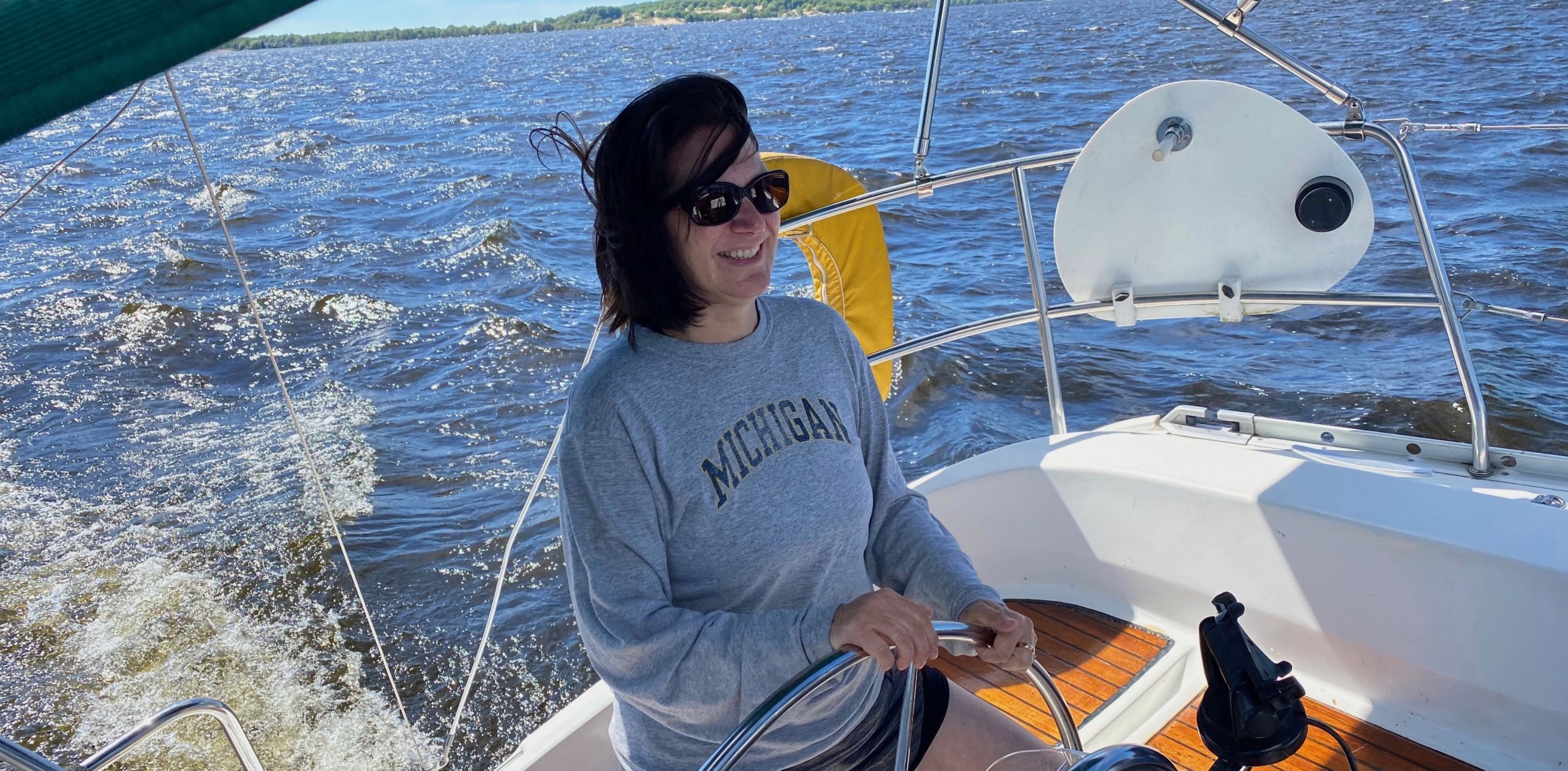As we arrived at the marina last Saturday, a gloriously perfect day, I told Trevor that I wanted to learn all the nautical lingo.
Trevor rattled off the basics. “Well, do you know bow, stern, port, starboard, fore, aft, mast, keel?”
“Um. Sure. I know that much from reading novels.” So far, so confident.
Our friend Trevor was finally taking my husband, Ron, and me out on his sailboat, the Genesis. He’s invited us many times, but for one reason or another, it has never worked out. Possibly I was a little scared? Possibly? Well not this time. This time we were doing it.
The Genesis is a 31-foot sailboat with one mast with a mainsail and a jib. I learned that sailboats are measured by their length at the water line. Trevor owns it—I mean, her—with two buddies, one of whom, he says, is a “genius with mechanical things.” Trevor emphasized several times that having such a person on board, so to speak, is vitally important if you’re going to own a boat. Boats require constant repairs. Fortunately, the only thing currently not working on the Genesis is the fridge.
cabin = the part under the deck; the Genesis can sleep six in her cabin, if you don’t mind being cozy; she also has a tiny kitchen (galley) and a bathroom (head)
cockpit = where you sit/stand to operate the boat; the steering wheel (helm) and instruments (no idea) are here
sole = the word you use instead of “floor”
Before we got under way, Trevor insisted on swabbing the deck. That is to say, he took a small cleaning brush to the cockpit sole and swept up some dirt and debris. Sailors tend to be fastidious. I kept asking him whether it was time to “batten down the hatches,” but he assured me that any relevant hatches were already sufficiently battened.
Ron had some experience sailing a one-person sunfish as a kid, but effectively we were both landlubbers on this journey. So Trevor set out to teach us some basics. First of all, he told us, there’s no such thing as a rope on a boat. They’re called lines. And they each have their own name. Everything has a specialized nautical name on a boat. I wrote down a lot of these terms because I love new words, but I soon got as tangled up in nautical language as the boat seems to be in ropes. I mean lines.
Once we had puttered out of the marina on motor power—the Genesis has an 18hp motor with an adorably small-but-mighty, three-blade folding propeller—we were out on Muskegon Lake. Winds at 15-20 knots. “Frisky,” Trevor called it. Air temp in the low 70s. Water temp in the low 50s.
mainsail = the main sail (ha!)
boom = the horizontal beam that holds the bottom of the main sail: watch out! it shifts back and forth across the boat and you can “boom” your head
furl = pull a sail in (like putting it away)
unfurl = let a sail out
reef = reduce the area of sail exposed to the wind
I tried to follow as Trev explained the complex relationship between wind, boat, and sails. I can’t say I really understood any of it. Apparently, you don’t usually sail with the wind blowing from behind as the uninitiated might imagine. Instead, you sail into or across the wind at an angle. Of course, the wind keeps changing. It gusts and calms and shifts around. Thus, sailing means making constant adjustments.
We had the mainsail up (partly reefed) on our way across Muskegon Lake out to the big lake. At a few points, I had to take the helm while Trevor and Ron cranked in or let out lines. There’s a cranking tool you insert into this winch thing—never got the terms for those gadgets, but they’re pretty cool. One feels ever so nautical when one is cranking (or possibly winching).
windex = an arrow, like a weathervane, at the top of the mast that tells you the relationship of the boat to the wind direction
working sheet = a line that is currently putting tension on a sail
lazy sheet = a line that is slack because it is not currently needed to put tension on a sail
When I was at the helm, I realized that it’s hard to see where you’re going. The sails and boom are right in front of you! You should be looking up at the windex. But then you’re not looking forward. You should be looking down at instruments, but what do they even mean? Half the time, the rest of your “crew” is outhauling and reefing and furling or whatever right in your way. And there are other boats and complicated rules about right of way. And piles of underwater rocks marked with a green flag. This is really hard!
Ron and I tried to help out and follow Trevor’s instructions as best we could. He’s a wonderful and patient teacher. Most of the time, I’m afraid, we were lazy sheets.
outhaul = line that hauls the sail out
furler = line that pulls the sail in, working opposite to the outhaul
At last, we made it out onto the big lake! The temperature dropped, the wind strengthened, and of course: waves. Waves at five feet. If you had told me that ahead of time, I would have been terrified. But it was OK. They were swells, and the boat handled them. I was able to stay loose and move with the boat.
“Sailboats love to tip,” Trevor remarked. He really meant lean. It’s actually hard to tip a sailboat over because the keel points down quite far below the bottom (hull) of the boat. But lean they do, so you get used to riding at an angle. You try to sit on the high side if you can.
I was pretty pleased with myself for not feeling seasick. At least for the first ten minutes. The water was a heaving expanse of black suede, even though the sky was clear and blue. Trevor barely had one second to relax, between handling the boat and instructing us.
jib = the smaller sail in front of the mainsail
genoa = a largish jib, the kind on the Genesis
“How did you learn to sail?” I kept trying to get Trevor to explain how he mastered this incredibly complex skill.
“You just learn,” was about the best I could get out of him. He took some classes. Other people taught him. It was love at first sail for him twenty years ago when a friend took him out on this very same water. The freedom of it! The excitement of riding the wind! That was it, he was hooked. So he started hanging around at the marina back in Jersey City, where he and his wife, Linda, had founded a kids’ ministry. Eventually, Trevor met generous people who owned sailboats and could start taking kids sailing as a regular part of the ministry. The idea was to give the kids a break from the city for a day, a chance to feel unfettered and empowered. They loved it. When Trevor moved to Michigan to plant a ministry site here, that’s when he got the Genesis.
tack = turn the bow of the boat through the wind
jibe = turn the stern of the boat through the wind
luffing = when the sail flaps around as you’re turning; luffing is OK in process but you want to get the sail taut ASAP
After a brief adventure on the big lake, we turned back. Eesh, now I was started to feel something uncomfortable in the pit of my stomach. Thankfully I had had nothing to eat since breakfast.
We renavigated the channel and, back in Muskegon Lake, Trevor set out to teach us about tacking and jibing. We sailed back and forth across the lake, avoiding boats, rock piles, shallow water, jetskiers, etc. Close reach, close hauled, beam reach—ack! At this point, I had reached full sailing-theory overload.
bury the rail = tipping over so far that the rail of the boat is in the water; sailors think this is fun
round up = not good; you have lost control and the wind is coming across the boat sideways
At one point, Trevor was down below looking for his GPS, foolishly leaving Ron and me in charge. Well, here comes a gust of wind. We immediately started rounding up and almost burying the rail.
“Trevor!” He stepped back up to the cockpit, totally calm. “If you get in trouble, just [let out the main sheet].” I don’t remember what he said. I was too grateful that we were not, after all, going to perish in the mighty deep.
That’s when I came up with an apt analogy, “Sailing is like a computer game,” I offered. “If you don’t know what you’re doing, the first thing you do is die.” Trevor thought that was funny.
Pentecost = the liturgical season when we get all metaphorical about wind
Ron and I were quite handy during the docking procedure, I must say. We leapt easily onto the dock and looped lines around cleats rather adeptly. Then we watched as Trevor worked the lines to get the boat juuuuuust right in the slip, fastening the lines with clever nautical knots. Once the boat was in place, he did this little crochet knot thing with the lines to make the loose ends tidy. It was a beautiful thing to watch.
So here is my conclusion about sailing:
It’s extremely hard.
You have to make constant adjustments.
You tip/lean a lot.
You have to know what you’re doing.
Now is the point where we get metaphorical. The wind is the Spirit, blowing about the little boats of our lives! Nah, because that would imply that the Spirit is an indifferent, implacable force with a strong tendency to fling us into watery graves unless we fight with mad skillz to harness its power. Somehow that doesn’t seem quite right.
Instead, I think about how we are living in these weeks in pretty tempestuous times. Wind and waves all around, threatening to capsize our individual and communal boats. I think about how important it is to have a “crew” and how we help each other as learners and teachers, trying to make all the constant adjustments. I think about how I’ve missed my spiritual crew at church these last months, not being able to worship with them in person. It has often felt like sailing my little spiritual boat alone. How are we supposed to see the way ahead? The windex is spinning.
We’re all queasy and tired for so many reasons. Whether you feel Jesus is asleep in the boat or actively outhauling and furling alongside us, I can’t say. We’re probably at different places on that point. Either way, there’s been plenty of leaning and luffing and burying the rail and rounding up. I doubt anyone thinks it’s super fun, even the adrenaline junkies.
I’m praying we can all reach a safer haven soon.
Thanks to Trevor Rubingh for his generosity and patience, including with proofreading this post. To learn more about New City Kids, check out their website here.





